INSTRUCTIONS FOR USE PENUMBRA COIL ... - Penumbra, Inc.
INSTRUCTIONS FOR USE PENUMBRA COIL ... - Penumbra, Inc.
INSTRUCTIONS FOR USE PENUMBRA COIL ... - Penumbra, Inc.
You also want an ePaper? Increase the reach of your titles
YUMPU automatically turns print PDFs into web optimized ePapers that Google loves.
R<br />
<strong>INSTRUCTIONS</strong> <strong>FOR</strong> <strong>USE</strong> <strong>PENUMBRA</strong> <strong>COIL</strong> SYSTEM<br />
2. The coil/delivery pusher is secured to the introducer sheath by means of a<br />
friction lock. Advance the delivery pusher past the friction lock to free the<br />
coil. Withdraw the delivery pusher back into the introducer sheath until the<br />
friction lock engages to resheath the coil.<br />
3. Carefully advance the coil out of the introducer sheath into heparinized<br />
saline. Examine the coil for kinks or other irregularities. If an irregularity is<br />
found, replace with a new coil.<br />
WARNING: Use of damaged coils may affect coil delivery and/or<br />
stability inside the aneurysm.<br />
4. With the distal end of the introducer sheath pointed downward and<br />
submerged in saline, carefully retract the coil fully into the introducer<br />
sheath.<br />
5. Introduce the distal end of the introducer sheath through the RHV into<br />
the hub of the microcatheter until the introducer sheath is firmly seated in<br />
the hub taper. Tighten the RHV around the introducer sheath to prevent<br />
retrograde flow of blood. Do not over-tighten. Excessive tightening could<br />
damage the coil or delivery pusher.<br />
6. Transfer the coil into the microcatheter by gently advancing the delivery<br />
pusher in a smooth continuous manner. Once the flexible portion of the<br />
delivery pusher has entered the microcatheter, loosen the RHV and<br />
remove the introducer sheath over the delivery pusher’s proximal end.<br />
NOTE: To resheath the coil, backload the delivery pusher into the<br />
introducer sheath from the same end it came out, and with the<br />
distal end of the introducer sheath pointed downward carefully<br />
retract the coil fully into the introducer sheath until the friction<br />
lock engages.<br />
7. Tighten the RHV on the delivery pusher to prevent retrograde blood flow<br />
while still allowing advancement of the delivery pusher.<br />
8. Visually verify that the flushing solution is infusing normally.<br />
9. Advance the delivery pusher until the coil fluoroscopy marker reaches the<br />
RHV. Fluoroscopic guidance should be initiated at this time. See Figure 1.<br />
Figure 1<br />
10. Continue advancing the coil under fluoroscopic guidance to the desired<br />
site. If coil placement is not satisfactory, slowly retract by pulling the<br />
delivery pusher proximally. The coil can then be deployed again. If the coil<br />
size is inappropriate, remove and replace with an appropriately sized coil.<br />
WARNING: Advance and retract coil slowly. Remove the coil if unusual<br />
friction is encountered. If unusual friction is encountered<br />
on subsequent coils, remove the microcatheter and<br />
carefully examine for damage.<br />
WARNING: If resistance is encountered when retracting the coil, retract<br />
the microcatheter until the resistance subsides.<br />
WARNING: Do not rotate the delivery pusher during use. Rotating the<br />
delivery pusher may result in premature detachment, which<br />
could lead to coil migration.<br />
11. Continue advancing the coil until the radiopaque marker on the delivery<br />
pusher aligns just beyond the microcatheter proximal radiopaque marker<br />
to form a “T”. At this point, the proximal end of the coil implant just exits<br />
2 (68)<br />
the microcatheter tip. Tighten the RHV on the delivery pusher to prevent<br />
further movement. See Figure 2.<br />
Figure 2<br />
WARNING: Verify repeatedly that the microcatheter is not under stress<br />
before coil detachment. Stored forces in the microcatheter<br />
could cause the tip to move during detachment, which<br />
could lead to aneurysm rupture.<br />
WARNING: Advancing the delivery pusher beyond the microcatheter<br />
tip could lead to aneurysm rupture.<br />
12. Remove the Detachment Handle from its packaging and place it within the<br />
sterile field.<br />
13. Reconfirm the delivery pusher radiopaque marker forms a “T” with the<br />
microcatheter proximal marker.<br />
NOTE: Coil detachment is not dependent on exact alignment, however,<br />
marker alignment will ensure that the proximal end of the coil<br />
implant just exits the microcatheter tip.<br />
14. Hold the delivery pusher distal to the black alignment zone. Advance the<br />
Detachment Handle over the proximal end of the delivery pusher until the<br />
black alignment zone is fully concealed within the Detachment Handle<br />
funnel and the delivery pusher comes to a stop inside the Detachment<br />
Handle. See Figure 3.<br />
Figure 3<br />
15. To detach the coil, use thumb to retract the Detachment Handle slider until<br />
it clicks.<br />
NOTE: After the slider clicks, release the slider to allow it to return to<br />
its original position.<br />
NOTE: The detachment mechanism will only activate upon hearing the<br />
click, not during the earlier phase of slider retraction.










